Study on the Dynamic Characteristics of a Wind Turbine Tower Based on Wind Tunnel Experiments
Abstract
:1. Introduction
2. Design of Scaled Wind Turbine Model
2.1. Similarity Criteria
2.2. Design Process
2.3. Measurement System Configuration
2.4. Dynamic and Aerodynamic Performance Verification
3. Analysis of Dynamic Responses under Operational and Parked Conditions
3.1. Dynamic Responses under Operating Conditions
3.2. Dynamic Responses under Parked Conditions
3.3. Comparison of Responses from Wind Tunnel Tests and Simulations
4. Modal Parameter Identification of the Wind Turbine Scaled Model
4.1. Identification Methods
4.2. Comparison of Modal Parameter Identification Results
5. Conclusions
- (1)
- A thrust-equivalent scaled wind turbine model designed with a low-Reynolds-number SD7032 airfoil can generally meet the requirements for similarity in dynamic characteristics and aerodynamic performance.
- (2)
- The scaled wind turbine model driven by a motor can simulate harmonic excitations induced by the rotation of the wind turbine rotor during operation. However, the harmonics at twice the rotor rotation frequency are more pronounced.
- (3)
- In the case of a feathered blade, when the yaw angle is 90°, the vibration amplitude of the tower in the FA direction is the largest. Within the yaw angle ranges from 10° to 50°, the vibration response of the tower in the SS direction is relatively severe. This phenomenon aligns with the variation trends of lift and drag coefficients of the low-Reynolds-number SD7032 airfoil with regard to angles of attack.
- (4)
- The design of the scaled model employs the similarity rule in dynamic characteristics and thrust equivalence, so the FA displacement amplitude of the scaled model can reflect that of the prototype wind turbine. However, due to the neglect of torque coefficient equivalence in the design, there is a significant discrepancy in the displacement amplitude in the SS direction compared to the prototype wind turbine.
- (5)
- The identification method based on rotor stop tests and the SSI methods can accurately identify the natural frequencies of the scaled wind turbine model. The modal damping identified during the operational condition is scattered, which is higher than structural damping due to the inclusion of aerodynamic damping. The identification errors for mode shapes are relatively small.
Author Contributions
Funding
Data Availability Statement
Conflicts of Interest
References
- Farina, A.; Anctil, A. Material consumption and environmental impact of wind turbines in the USA and globally. Resour. Conserv. Recycl. 2022, 176, 105938. [Google Scholar] [CrossRef]
- GWEC. Global Offshore Wind Report 2023; GWEC: Lisbon, Portugal, 2023. [Google Scholar]
- Rodrigues, S.; Restrepo, C.; Kontos, E.; Teixeira Pinto, R.; Bauer, P.; Global Wind Energy Council. Trends of offshore wind projects. Renew. Sustain. Energy Rev. 2015, 49, 1114–1135. [Google Scholar] [CrossRef]
- Chen, X.; Li, C.; Xu, J. Failure investigation on a coastal wind farm damaged by super typhoon: A forensic engineering study. J. Wind Eng. Ind. Aerodyn. 2015, 147, 132–142. [Google Scholar] [CrossRef]
- Ma, Y.; Martinez-Vazquez, P.; Baniotopoulos, C. Wind turbine tower collapse cases: A historical overview. Proc. Inst. Civ. Eng.—Struct. Build. 2019, 172, 547–555. [Google Scholar] [CrossRef]
- Hawbecker, P.; Basu, S.; Manuel, L. Realistic simulations of the July 1, 2011 severe wind event over the Buffalo Ridge Wind Farm. Wind Energy 2017, 20, 1803–1822. [Google Scholar] [CrossRef]
- Banerjee, A.; Chakraborty, T.; Matsagar, V.; Achmus, M. Dynamic analysis of an offshore wind turbine under random wind and wave excitation with soil-structure interaction and blade tower coupling. Soil. Dyn. Earthq. Eng. 2019, 125, 105699. [Google Scholar] [CrossRef]
- Zhu, H.; Li, D.; Xu, J. Dynamic analysis and optimization of a wind turbine tower subject to wind and earthquake loads. Struct. Des. Tall Spec. Build. 2022, 31, e1971. [Google Scholar] [CrossRef]
- Chen, C.; Duffour, P.; Fromme, P. Modelling wind turbine tower-rotor interaction through an aerodynamic damping matrix. J. Sound. Vib. 2020, 489, 115667. [Google Scholar] [CrossRef]
- Chen, C.; Duffour, P.; Fromme, P.; Hua, X. Numerically efficient fatigue life prediction of offshore wind turbines using aerodynamic decoupling. Renew. Energy 2021, 178, 1421–1434. [Google Scholar] [CrossRef]
- Yan, Y.; Li, C.; Li, Z. Buckling analysis of a 10 MW offshore wind turbine subjected to wind-wave-earthquake loadings. Ocean Eng. 2021, 236, 109452. [Google Scholar] [CrossRef]
- Shi, S.; Zhai, E.; Xu, C.; Iqbal, K.; Sun, Y.; Wang, S. Influence of pile-soil interaction on dynamic properties and response of offshore wind turbine with monopile foundation in sand site. Appl. Ocean Res. 2022, 126, 103279. [Google Scholar] [CrossRef]
- Han, R.; Wang, L.; Wang, T.; Gao, Z.; Wu, J. Study of Dynamic Response Characteristics of the Wind Turbine Based on Measured Power Spectrum in the Eyewall Region of Typhoons. NATO Adv. Sci. Inst. Ser. E Appl. Sci. 2019, 9, 2392. [Google Scholar] [CrossRef]
- Hulskamp, A.W.; van Wingerden, J.W.; Barlas, T.; Champliaud, H.; van Kuik, G.A.M.; Bersee, H.E.N.; Verhaegen, M. Design of a scaled wind turbine with a smart rotor for dynamic load control experiments. Wind Energy 2011, 14, 339–354. [Google Scholar] [CrossRef]
- Sauder, H.S.; Sarkar, P.P. Real-time prediction of aeroelastic loads of wind turbine blades in gusty and turbulent wind using an improved load model. Eng. Struct. 2017, 147, 103–113. [Google Scholar] [CrossRef]
- Hu, H.; Yang, Z.; Sarkar, P. Dynamic wind loads and wake characteristics of a wind turbine model in an atmospheric boundary layer wind. Exp. Fluids 2012, 52, 1277–1294. [Google Scholar] [CrossRef]
- Noda, H.; Ishihara, T. Wind tunnel test on mean wind forces and peak pressures acting on wind turbine nacelles. Wind Energy 2014, 17, 1–17. [Google Scholar] [CrossRef]
- Lu, M.-M.; Ke, S.-T.; Wu, H.-X.; Gao, M.-E.; Tian, W.-X.; Wang, H. A novel forecasting method of flutter critical wind speed for the 15 MW wind turbine blade based on aeroelastic wind tunnel test. J. Wind Eng. Ind. Aerodyn. 2022, 230, 105195. [Google Scholar] [CrossRef]
- Gao, R.; Yang, J.; Yang, H.; Wang, X. Wind-tunnel experimental study on aeroelastic response of flexible wind turbine blades under different wind conditions. Renew. Energy 2023, 219, 119539. [Google Scholar] [CrossRef]
- Ma, Y.; Chen, C.; Fan, T.; Lu, H.; Fang, J. An innovative aerodynamic design methodology of wind turbine blade models for wind tunnel real-time hybrid tests based on genetic algorithm. Ocean Eng. 2022, 257, 111724. [Google Scholar] [CrossRef]
- Fontecha, R.; Kemper, F.; Feldmann, M.; Witter, S.; Schelenz, R. Along-Wind Aerodynamic Damping of Wind Turbine Towers: Determination by Wind Tunnel Tests and Impact on Tower Lifetime. Energies 2022, 15, 1984. [Google Scholar] [CrossRef]
- Kim, Y.C. Aeroelastic and Aerodynamic Tests of Wind Turbine with Various Polygonal Towers. NATO Adv. Sci. Inst. Ser. E Appl. Sci. 2021, 11, 11740. [Google Scholar] [CrossRef]
- Bottasso, C.L.; Campagnolo, F.; Petrović, V. Wind tunnel testing of scaled wind turbine models: Beyond aerodynamics. J. Wind Eng. Ind. Aerodyn. 2014, 127, 11–28. [Google Scholar] [CrossRef]
- Martin, H.R.; Kimball, R.W.; Viselli, A.M.; Goupee, A.J. Methodology for Wind/Wave Basin Testing of Floating Offshore Wind Turbines. J. Offshore Mech. Arct. Eng. 2014, 136, 020905. [Google Scholar] [CrossRef]
- Yang, W.; Yu, M.; Yan, B.; Huang, G.; Yang, Q.; Zhang, S.; Hong, T.; Zhou, X.; Deng, X. Wind Tunnel Tests of Wake Characteristics for a Scaled Wind Turbine Model Based on Dynamic Similarity. Energies 2022, 15, 6165. [Google Scholar] [CrossRef]
- Abdelkader, A.; Aly, A.M.; Rezaee, M.; Bitsuamlak, G.T.; El Naggar, M.H. On the evaluation of wind loads for wind turbines’ foundation design: Experimental and numerical investigations. Struct. Des. Tall Spec. Build. 2017, 26, e1362. [Google Scholar] [CrossRef]
- Tian, W.; Ozbay, A.; Hu, H. A wind tunnel study of wind loads on a model wind turbine in atmospheric boundary layer winds. J. Fluids Struct. 2019, 85, 17–26. [Google Scholar] [CrossRef]
- Verelst, D.R.S.; Larsen, T.J.; van Wingerden, J.W. Wind tunnel tests of a free yawing downwind wind turbine. J. Phys. Conf. Ser. 2014, 555, 012103. [Google Scholar] [CrossRef]
- Frederik, J.A.; Weber, R.; Cacciola, S.; Campagnolo, F.; Croce, A.; Bottasso, C.; van Wingerden, J.-W. Periodic dynamic induction control of wind farms: Proving the potential in simulations and wind tunnel experiments. Wind Energy Sci. Discuss. 2019, 1–18. [Google Scholar] [CrossRef]
- Nanos, E.M.; Bottasso, C.L.; Campagnolo, F.; Mühle, F.; Letizia, S.; Iungo, G.V.; Rotea, M.A. Design, steady performance and wake characterization of a scaled wind turbine with pitch, torque and yaw actuation. Wind Energy Sci. 2022, 7, 1263–1287. [Google Scholar] [CrossRef]
- National Renewable Energy Laboratory (NREL). OpenFAST Documentation—Release v2.3.0. 2020. Available online: https://readthedocs.org/projects/mas-openfast-fork/downloads/pdf/latest/ (accessed on 2 April 2020).
- He, R.; Sun, H.; Gao, X.; Yang, H. Wind tunnel tests for wind turbines: A state-of-the-art review. Renew. Sustain. Energy Rev. 2022, 166, 112675. [Google Scholar] [CrossRef]
- Krogstad, P.-Å.; Eriksen, P.E. “Blind test” calculations of the performance and wake development for a model wind turbine. Renew. Energy 2013, 50, 325–333. [Google Scholar] [CrossRef]
- McTavish, S.; Feszty, D.; Nitzsche, F. Evaluating Reynolds number effects in small-scale wind turbine experiments. J. Wind Eng. Ind. Aerodyn. 2013, 120, 81–90. [Google Scholar] [CrossRef]
- McTavish, S.; Feszty, D.; Nitzsche, F. An experimental and computational assessment of blockage effects on wind turbine wake development. Wind Energy 2014, 17, 1515–1529. [Google Scholar] [CrossRef]
- Treuren, V.; Kenneth, W. Small-Scale Wind Turbine Testing in Wind Tunnels Under Low Reynolds Number Conditions. J. Energy Res. Technol. 2015, 137, 051208. [Google Scholar] [CrossRef]
- de Ridder, E.-J.; Otto, W.; Zondervan, G.-J.; Huijs, F.; Vaz, G. Development of a scaled-down floating wind turbine for offshore basin testing. In International Conference on Offshore Mechanics and Arctic Engineering; American Society of Mechanical Engineers: New York, NY, USA, 2014; p. V09AT09A027. [Google Scholar]
- Fowler, M.J.; Kimball, R.W.; Thomas, D.A.; Goupee, A.J. Design and Testing of Scale Model Wind Turbines for Use in Wind/Wave Basin Model Tests of Floating Offshore Wind Turbines. In Proceedings of the ASME 2013 32nd International Conference on Ocean, Offshore and Arctic Engineering, Nantes, France, 9–14 June 2013; p. V008T09A004. [Google Scholar]
- Wen, B.; Tian, X.; Dong, X.; Li, Z.; Peng, Z.; Zhang, W.; Wei, K. Design approaches of performance-scaled rotor for wave basin model tests of floating wind turbines. Renew. Energy 2020, 148, 573–584. [Google Scholar] [CrossRef]
- Bayati, I.; Belloli, M.; Bernini, L.; Zasso, A. Aerodynamic design methodology for wind tunnel tests of wind turbine rotors. J. Wind Eng. Ind. Aerodyn. 2017, 167, 217–227. [Google Scholar] [CrossRef]
- Marten, D.; Wendler, J. QBlade Short Manual. 2018. Available online: https://www.researchgate.net/profile/David-Marten/publication/281279669_QBlade_Short_Manual_v08/links/55dedad208ae79830bb59604/QBlade-Short-Manual-v08.pdf (accessed on 27 August 2015).
- Damgaard, M.; Ibsen, L.; Andersen, L.; Andersen, J. Cross-wind modal properties of offshore wind turbines identified by full scale testing. J. Wind Eng. Ind. Aerodyn. 2013, 116, 94–108. [Google Scholar] [CrossRef]
- Shirzadeh, R.; Devriendt, C.; Bidakhvidi, M.; Guillaume, P. Experimental and computational damping estimation of an offshore wind turbine on a monopile foundation. J. Wind Eng. Ind. Aerodyn. 2013, 120, 96–106. [Google Scholar] [CrossRef]
- Caicedo, J.M.; Dyke Shirley, J.; Johnson Erik, A. Natural Excitation Technique and Eigensystem Realization Algorithm for Phase I of the IASC-ASCE Benchmark Problem: Simulated Data. J. Eng. Mech. 2004, 130, 49–60. [Google Scholar] [CrossRef]
- Bajrić, A.; Høgsberg, J.; Rüdinger, F. Evaluation of damping estimates by automated Operational Modal Analysis for offshore wind turbine tower vibrations. Renew. Energy 2018, 116, 153–163. [Google Scholar] [CrossRef]
- Brincker, R.; Ventura, C.E. Introduction to Operational Modal Analysis; John Wiley & Sons: Oxford, UK, 2015. [Google Scholar]
- Zahid, F.B.; Ong, Z.C.; Khoo, S.Y. A review of operational modal analysis techniques for in-service modal identification. J. Brazil Soc. Mech. Sci. Eng. 2020, 42, 398. [Google Scholar] [CrossRef]
- Ozbek, M.; Meng, F.; Rixen, D.J. Challenges in testing and monitoring the in-operation vibration characteristics of wind turbines. Mech. Syst. Signal Process 2013, 41, 649–666. [Google Scholar] [CrossRef]
- Xiao, F.; Tian, C.; Wait, I.; Yang, Z.; Still, B.; Chen, G.S. Condition monitoring and vibration analysis of wind turbine. Adv. Mech. Eng. 2020, 12, 168781402091378. [Google Scholar] [CrossRef]
- Dai, K.; Wang, Y.; Huang, Y.; Zhu, W.; Xu, Y. Development of a modified stochastic subspace identification method for rapid structural assessment of in-service utility-scale wind turbine towers. Wind Energy 2017, 20, 1687–1710. [Google Scholar] [CrossRef]

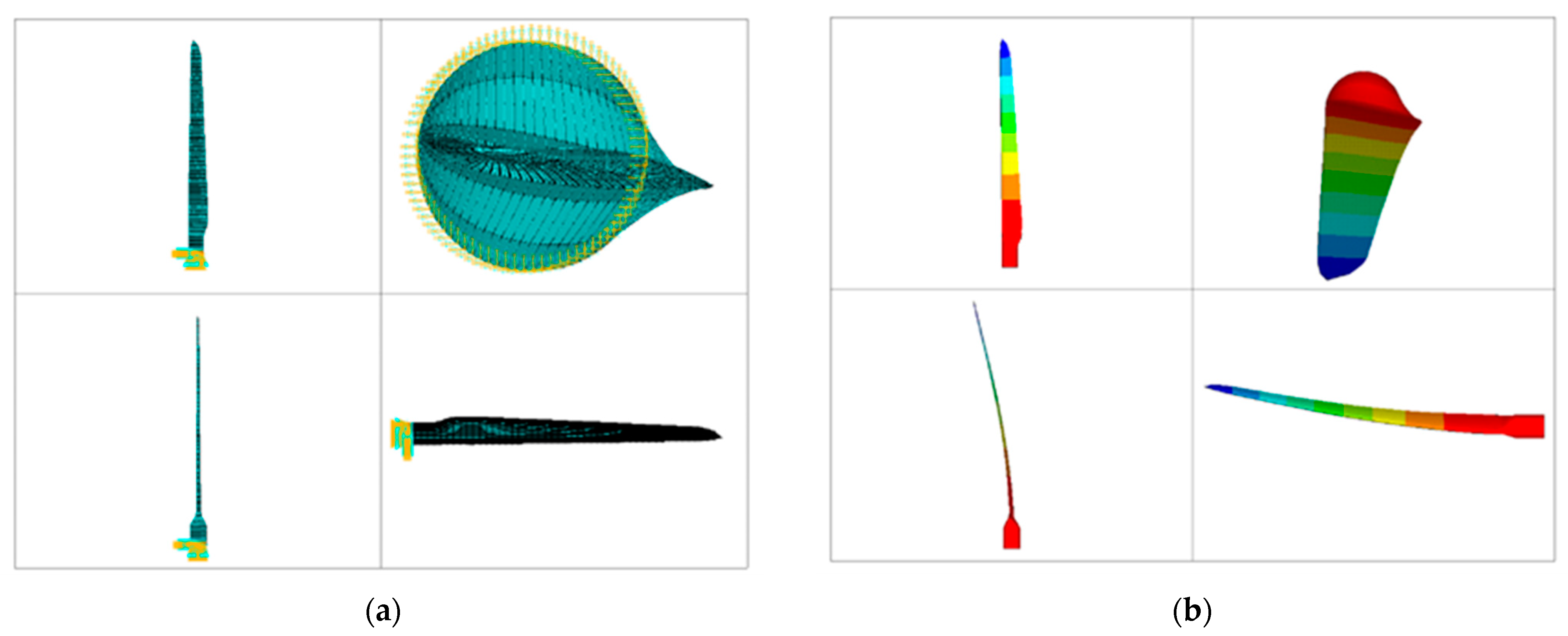


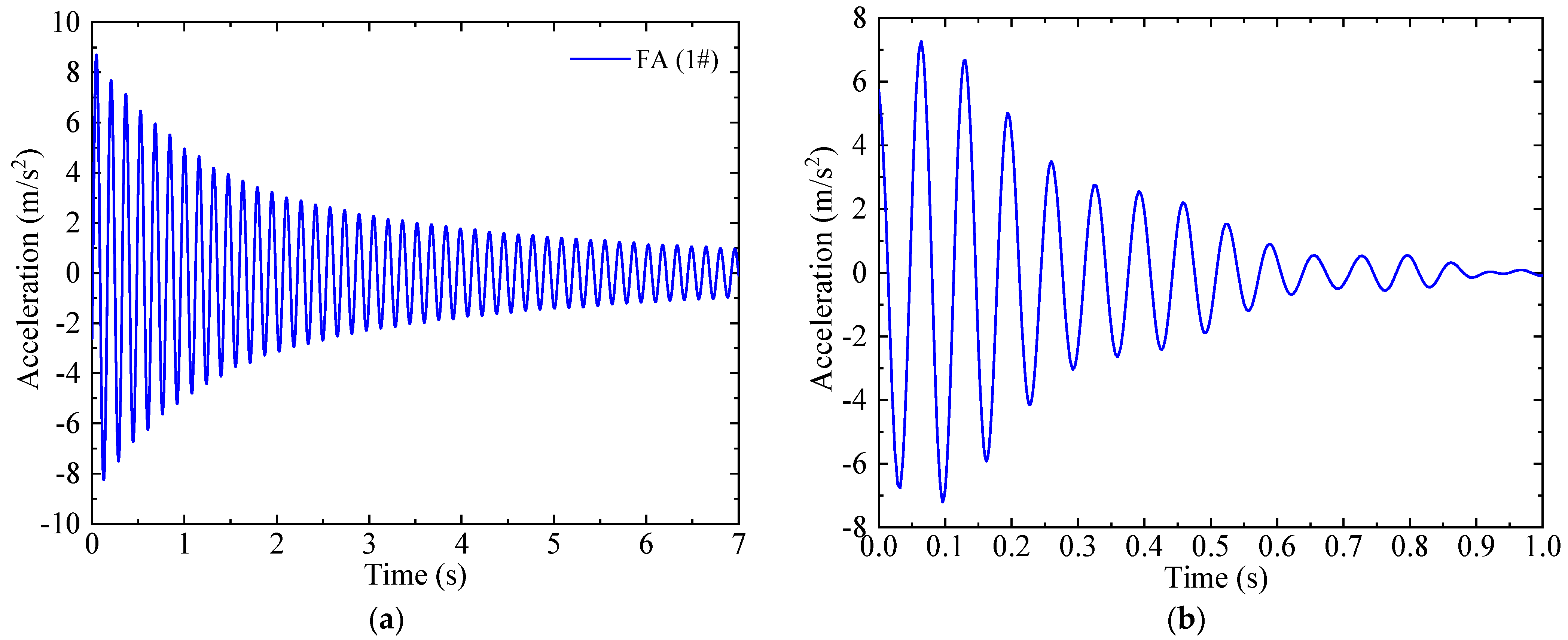
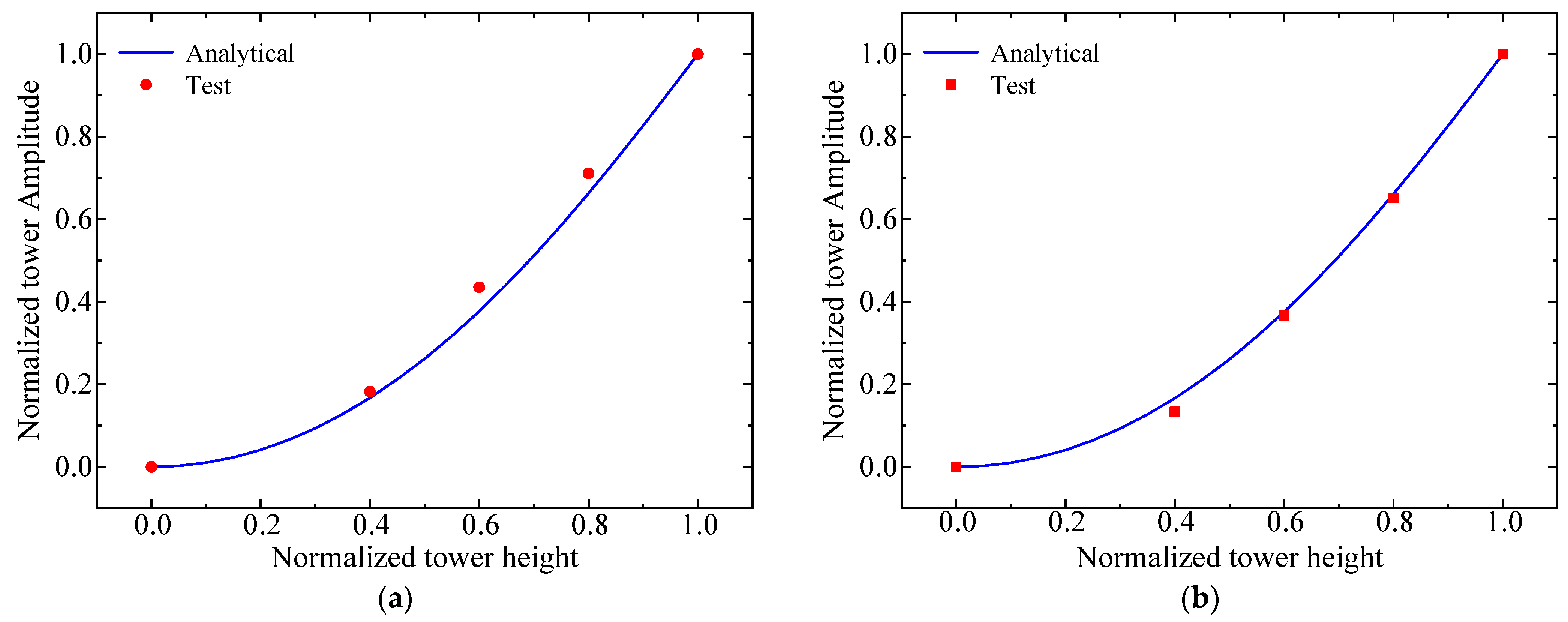
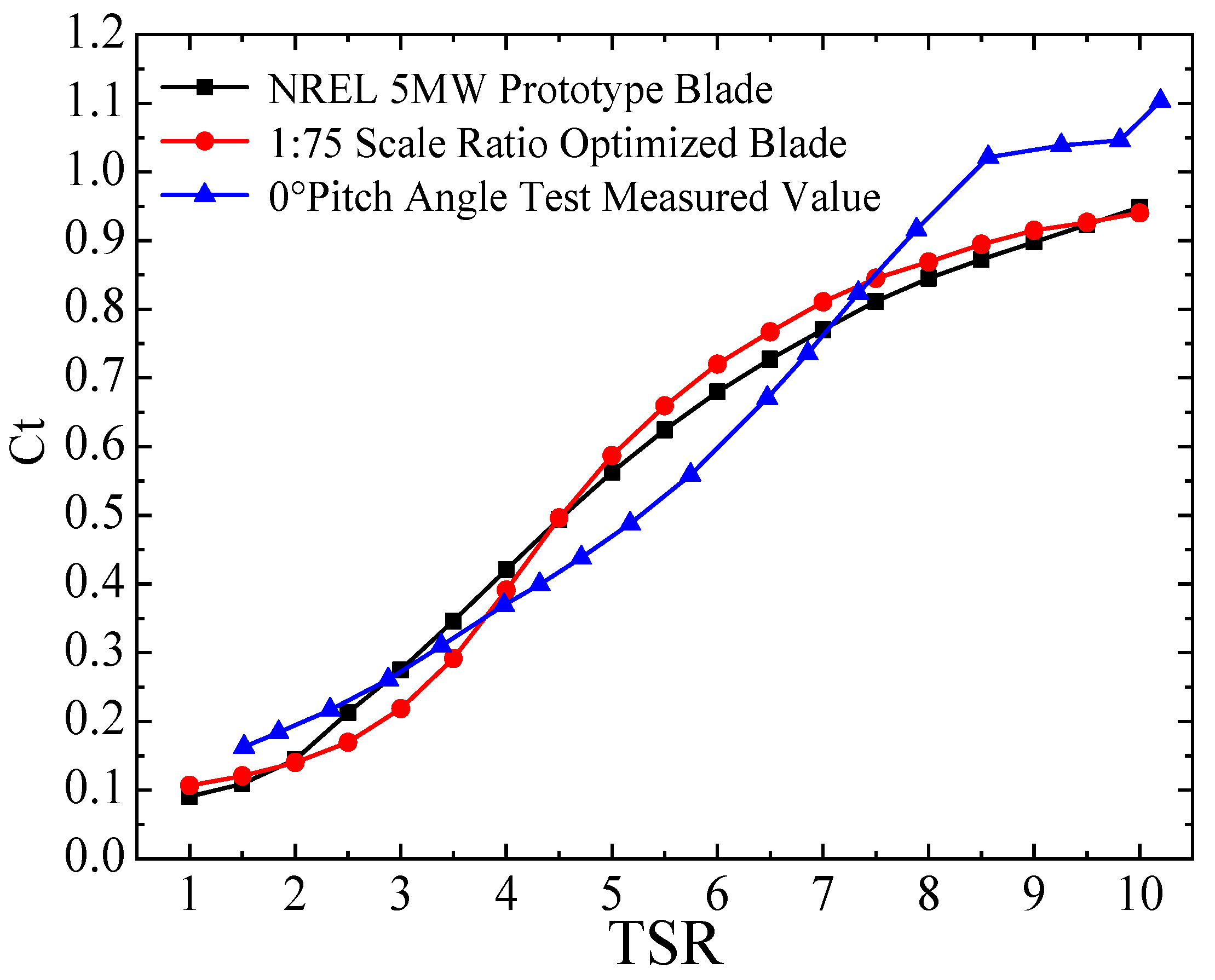

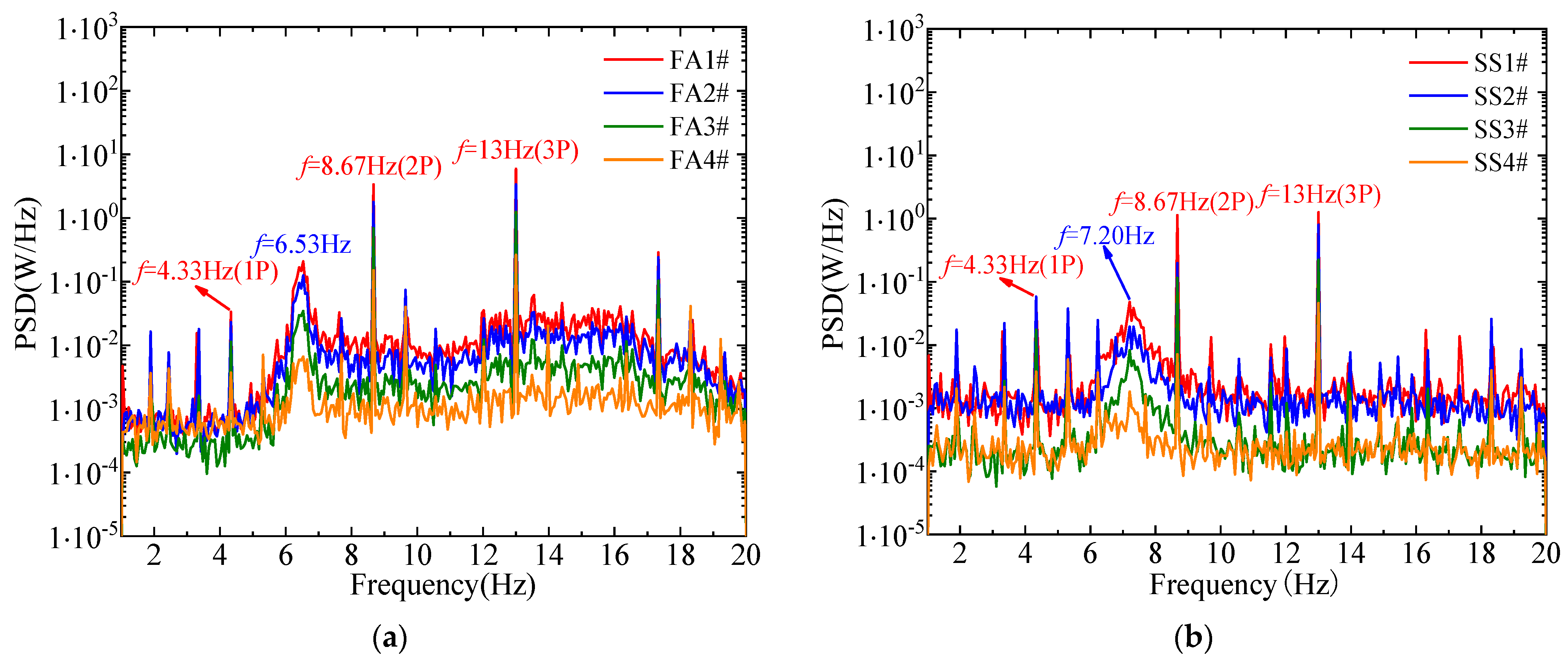

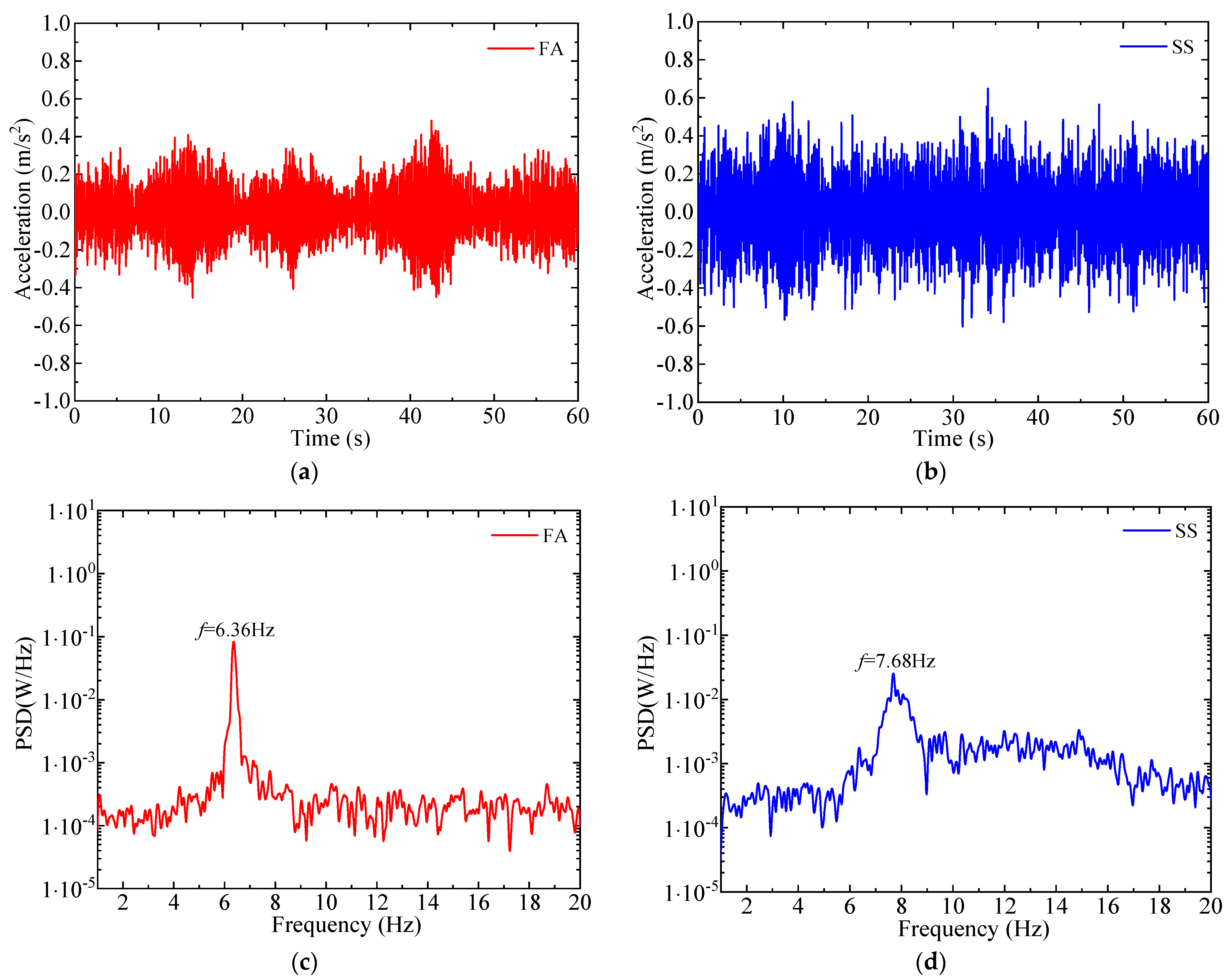


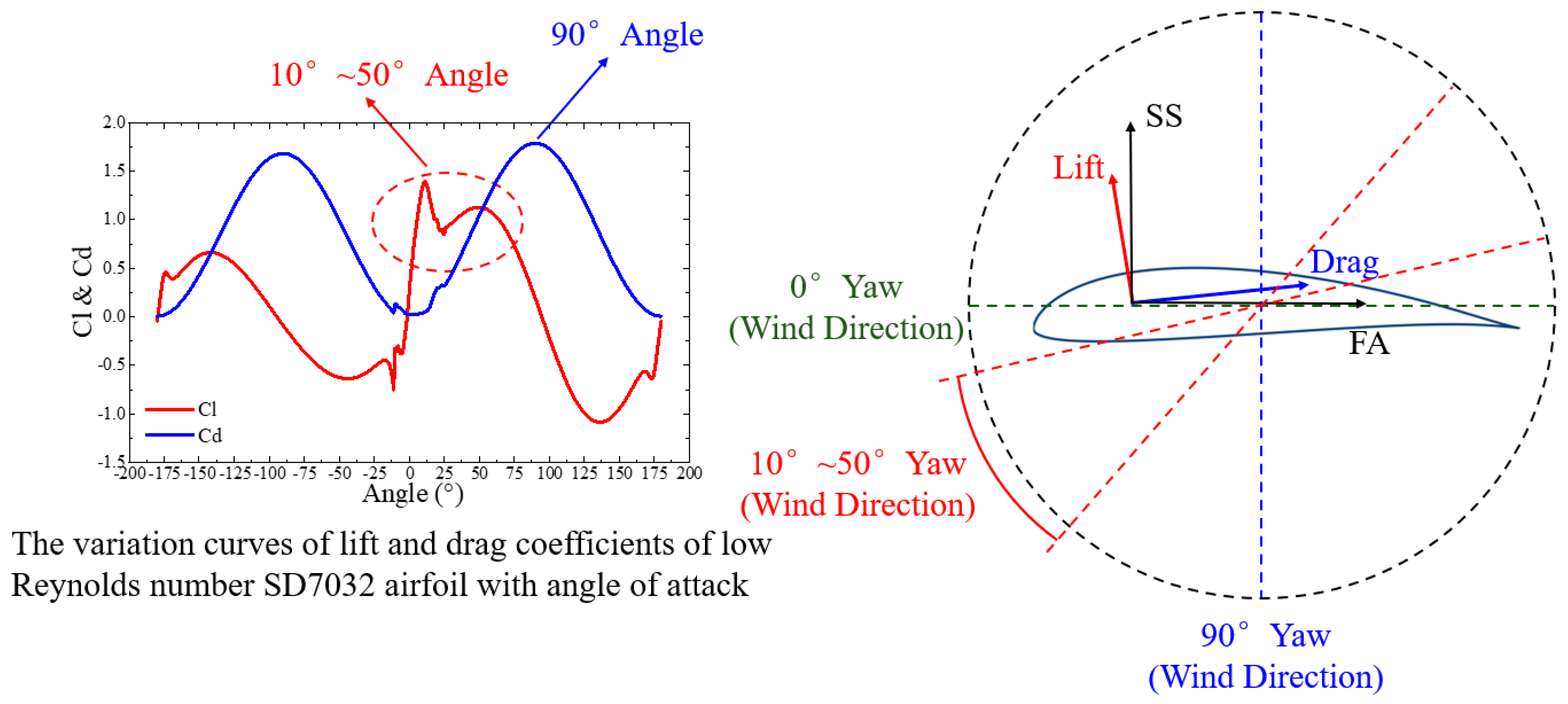
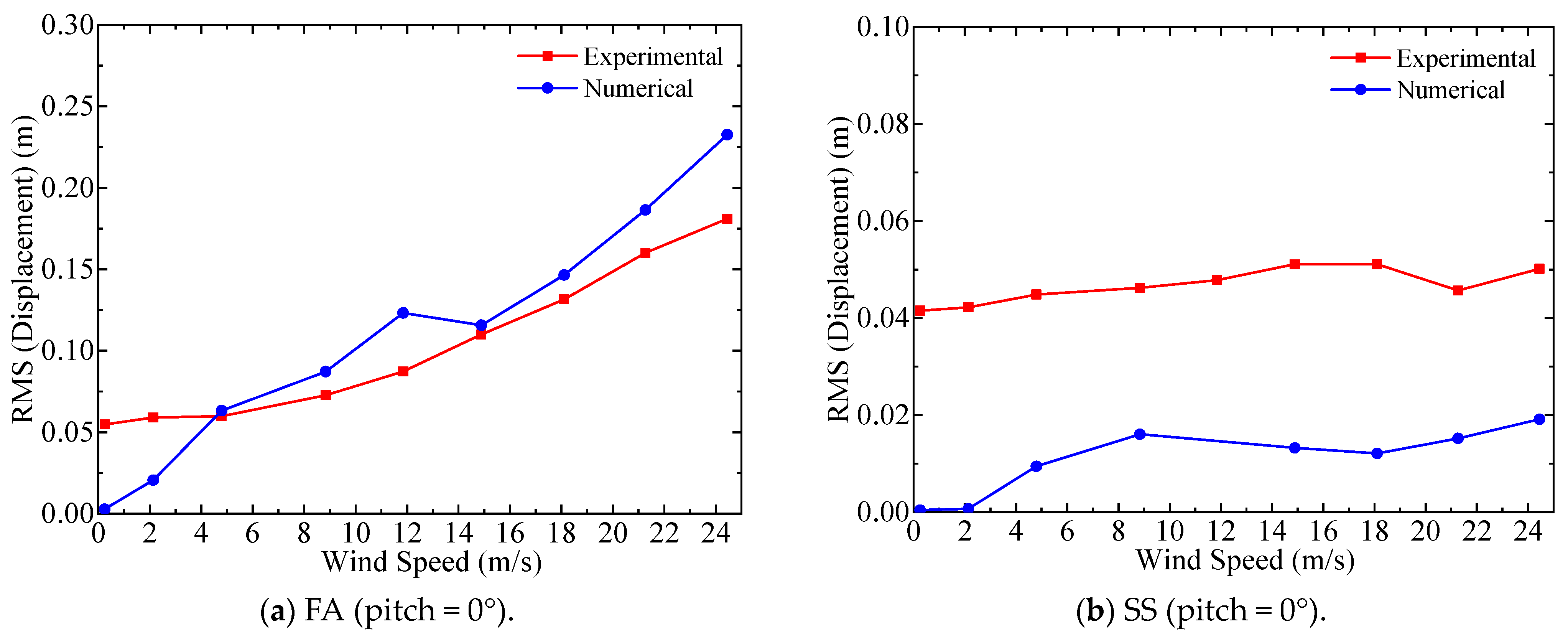

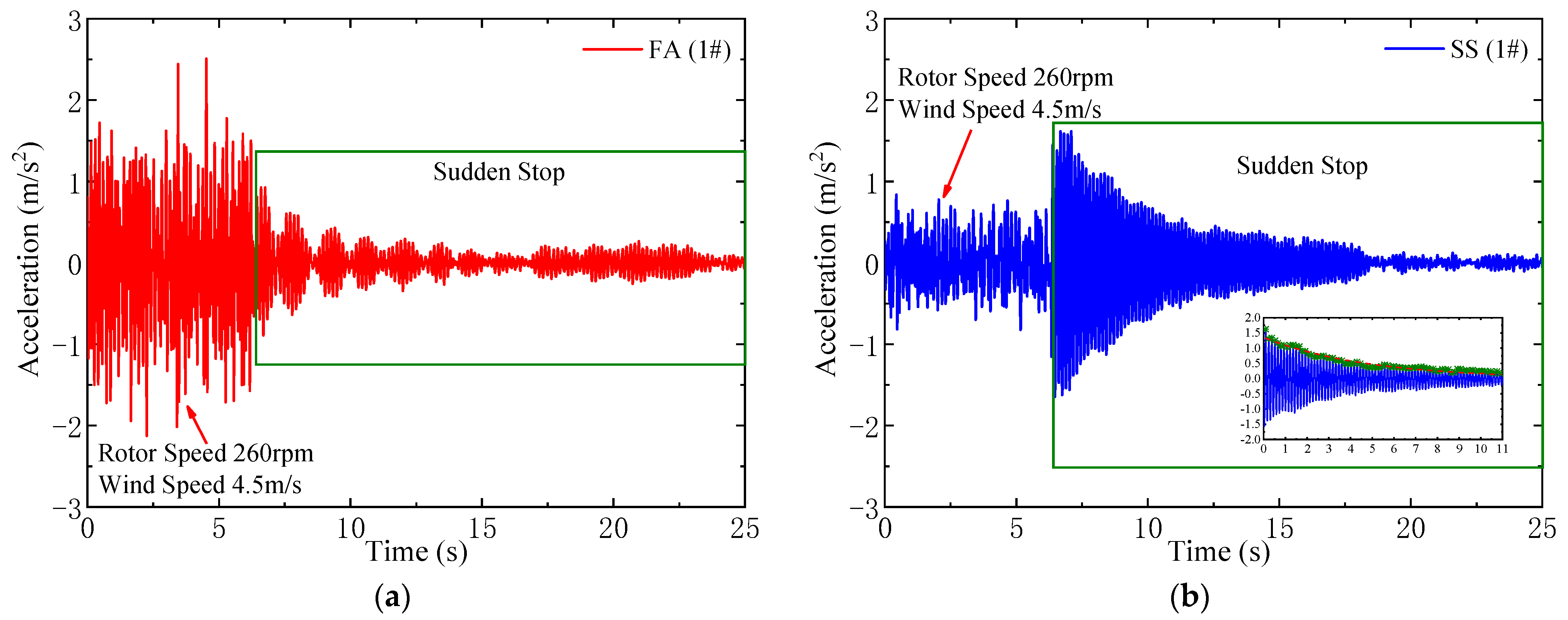



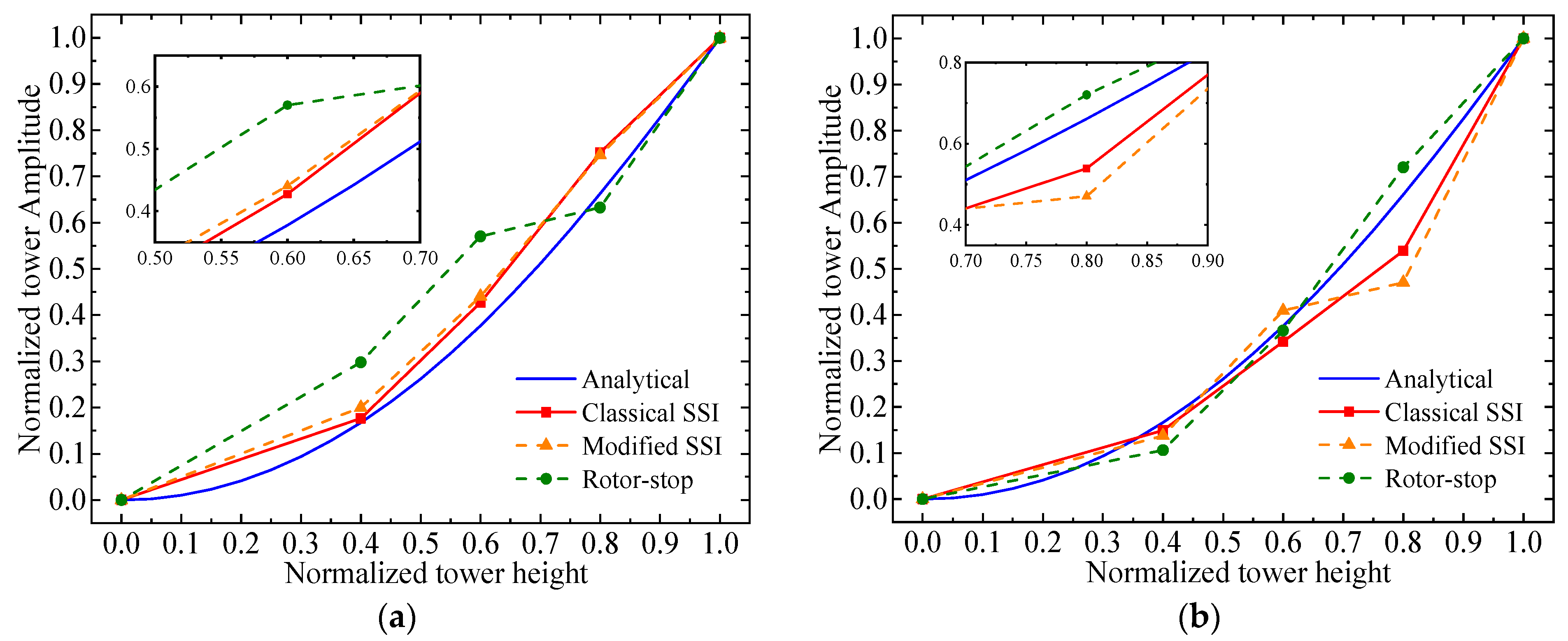
| Parameter | Full-Scale NREL 5 MW | Similarity Ratio | Aeroelastic Model |
|---|---|---|---|
| Blade Length (m) | 61.5 | 1/n | 0.820 |
| Hub Radius (m) | 1.5 | 1/n | 0.020 |
| Tower Height (m) | 87.6 | 1/n | 1.168 |
| Hub Height (m) | 90 | 1/n | 1.200 |
| Rotor Mass and Nacelle Mass:Tower Mass | 1:1 | - | 1:1 |
| First-Order Natural Frequency of the Tower in the FA Direction (Hz) | 0.324 | n/m | 6.943 |
| First-Order Natural Frequency of the Tower in the SS Direction (Hz) | 0.312 | n/m | 6.686 |
| First-Order Natural Frequency of Blade Flapwise (Hz) | 0.68 | n/m | 14.57 |
| Rated Rotor Speed (rpm) | 12.1 | n/m | 259 |
| Rated Wind Speed (m/s) | 11.4 | 1/m | 3.26 |
| Condition | Wind Speed (m/s) | Rotor Speed (rpm) | Condition | Wind Speed (m/s) | Rotor Speed (rpm) |
|---|---|---|---|---|---|
| 1 | 1.37 | 160 | 5 | 2.49 | 220 |
| 2 | 1.66 | 170 | 6 | 2.75 | 240 |
| 3 | 1.92 | 180 | 7 | 3.06 | 255 |
| 4 | 2.21 | 190 | 8 | 3.35~6.91 | 260 |
Disclaimer/Publisher’s Note: The statements, opinions and data contained in all publications are solely those of the individual author(s) and contributor(s) and not of MDPI and/or the editor(s). MDPI and/or the editor(s) disclaim responsibility for any injury to people or property resulting from any ideas, methods, instructions or products referred to in the content. |
© 2024 by the authors. Licensee MDPI, Basel, Switzerland. This article is an open access article distributed under the terms and conditions of the Creative Commons Attribution (CC BY) license (https://creativecommons.org/licenses/by/4.0/).
Share and Cite
Yao, Y.; Yu, C.; Rao, M.; Wang, Z.; Hua, X.; Chen, C. Study on the Dynamic Characteristics of a Wind Turbine Tower Based on Wind Tunnel Experiments. Energies 2024, 17, 4080. https://doi.org/10.3390/en17164080
Yao Y, Yu C, Rao M, Wang Z, Hua X, Chen C. Study on the Dynamic Characteristics of a Wind Turbine Tower Based on Wind Tunnel Experiments. Energies. 2024; 17(16):4080. https://doi.org/10.3390/en17164080
Chicago/Turabian StyleYao, Yong, Chi Yu, Mumin Rao, Zhaowei Wang, Xugang Hua, and Chao Chen. 2024. "Study on the Dynamic Characteristics of a Wind Turbine Tower Based on Wind Tunnel Experiments" Energies 17, no. 16: 4080. https://doi.org/10.3390/en17164080





